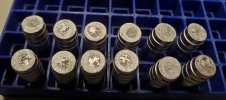Dimner
Named Man
I'm at my wits end. Usually I can get the right pace, mold temp, etc where I can get perfect bases with my aluminum molds. However, this is my first 5 cavity in 30 cal. Before, it had just been 22 cal. That one is easy to regulate mold temp.
The problem I'm having is with cratered bases, ripped bases, pockmarked. Or conversely, when I can produce perfect bases with the mold, I have 85% defects on the body of the bullets due to fillout. I'm pretty sure that's because when I can get the bullets cool enough to cut the sprue without any crater issues, the mold has cooled down too much. Then the next few pours are with body defects.
So when the mold is at proper temp (I think around 425 based on my measurements) and I cut the sprue 3 seconds after the sprue goes frosty, I get constant cratered bases. I have tried the damp cloth on the sprue method of cooling down only the sprue, but either I don't cool it down enough and issues persist, or I cool it down too much and we are back into body defect issues.
I have poured about 5 quarts of these bullets and just cannot find the formula for getting this right. The best I have been able to do is cast 3 cavities at a time with a 40% rejection rate.
Data:
Mold: NOE 30 hunter (311-190-FN) 5 Cavity Aluminum
Alloy: 95/3sb/2sn - pretty sure about this as the components used to create this alloy were assayed.
Temp: Have tried 710 as well as 730 - Using a Hatch made PID
Method: Ladle Pour
First pic, is what I'm expecting as good bases. The next two are what 85% of my casting looks like with this mold.
The problem I'm having is with cratered bases, ripped bases, pockmarked. Or conversely, when I can produce perfect bases with the mold, I have 85% defects on the body of the bullets due to fillout. I'm pretty sure that's because when I can get the bullets cool enough to cut the sprue without any crater issues, the mold has cooled down too much. Then the next few pours are with body defects.
So when the mold is at proper temp (I think around 425 based on my measurements) and I cut the sprue 3 seconds after the sprue goes frosty, I get constant cratered bases. I have tried the damp cloth on the sprue method of cooling down only the sprue, but either I don't cool it down enough and issues persist, or I cool it down too much and we are back into body defect issues.
I have poured about 5 quarts of these bullets and just cannot find the formula for getting this right. The best I have been able to do is cast 3 cavities at a time with a 40% rejection rate.
Data:
Mold: NOE 30 hunter (311-190-FN) 5 Cavity Aluminum
Alloy: 95/3sb/2sn - pretty sure about this as the components used to create this alloy were assayed.
Temp: Have tried 710 as well as 730 - Using a Hatch made PID
Method: Ladle Pour
First pic, is what I'm expecting as good bases. The next two are what 85% of my casting looks like with this mold.
Attachments
Last edited:



